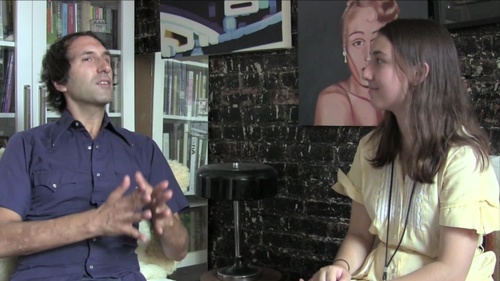Nick Hallett: Voice & Light Systems, Part One: Meredith Monk’s Our Lady of Late
Nick Hallett—singer, composer, and downtown impresario—creates a four-part series, as part of New Museum’s newly launched RE:NEW RE:PLAY Performance Residency Series, at the Museum’s theater connecting the human voice to multimedia ritual.
Nick Hallett began his residency on May 7 with a selection of songs from Meredith Monk’s Our Lady of Late, a cycle for solo voice and wineglass drone, written in 1972 and rendered as a concert piece by the composer a year later. The performer began by singing in unison with the fingered glass, then gradually diverging from the pitch in microtonal increments, which resulted in the phenomenon of “beats,” rhythmic pulses that were created in the interference patterns of two waveforms. Eventually, vibrato was added into the mix. In this way, Our Lady of Late introduced its audience to “extended vocal technique,” wherein the singer explored a diverse vocabulary of sounds and performative states. Hallett’s interpretation—working within the composer’s clearly defined parameters—incorporated a multimedia table of his design in collaboration with live cinema artist Brock Monroe. Pure light focused onto the glass produces an aqueous, mutable projection. Hallett was joined by singers Emily Eagen and Peter Sciscioli (members of The M6: Meredith Monk Music Third Generation), who performed duets from Meredith Monk’s Facing North and musician Miguel Frasconi, who played the percussion solos originated by Collin Walcott in the original performances of Our Lady of Late.
In collaboration with a rotating cast of performers and artists, Hallett presented original music and performance alongside new interpretations of celebrated vocal works by Meredith Monk and Karlheinz Stockhausen. The singing voice was seen here in its rawest state, stripped of its language-based sensibilities, and more as a flexible instrument of sound, capable of producing protosemantic, acoustic phenomena. As such, concepts of drone, repetition, and improvisation prevail over the tropes of traditional song. Each evening was staged using pure light, illuminated objects, and projection methods derived from structuralist film and the psychedelic lightshow to create a live, interdisciplinary synthesis of sound and image. Taking from John Cage’s maxim that “art should not be different than life, but an action within life,” “Voice & Light Systems” revisits the Zen-Buddhism-inspired methodologies popular among Western artists during the 1960s and ’70s as ritual practices in and of themselves, envisioning their scores much as sacred texts in a pre-literary culture, to be rendered as expressions of devout “art consciousness.” With this experimental tradition as a starting point, Hallett began to develop new work for contemporary contemplation, with the voice—the most basic instrument of artistic expression—at its core.
